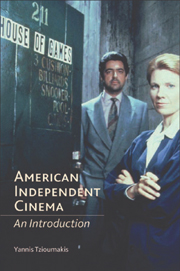Book contents
- Frontmatter
- Contents
- Analytical Table of Contents
- List of Tables
- List of Case Studies
- List of Figures
- Acknowledgements
- Dedication
- Introduction: Problems of Definition and the Discourse of American Independent Cinema
- Part I American Independent Cinema in the Studio Years (mid-1920s–late 1940s)
- Part II The Transitional Years (late 1940s–late 1960s)
- Part III Contemporary American Independent Cinema (late 1960s–present)
- 5 The New Hollywood and the Independent Hollywood
- 6 American Independent Cinema in the Age of the Conglomerates
- 7 Mini-majors and Major Independents
- 8 The Institutionalisation of American Independent Cinema
- Epilogue: From Independent to ‘Specialty’ Cinema
- Bibliography
- Index
6 - American Independent Cinema in the Age of the Conglomerates
from Part III - Contemporary American Independent Cinema (late 1960s–present)
- Frontmatter
- Contents
- Analytical Table of Contents
- List of Tables
- List of Case Studies
- List of Figures
- Acknowledgements
- Dedication
- Introduction: Problems of Definition and the Discourse of American Independent Cinema
- Part I American Independent Cinema in the Studio Years (mid-1920s–late 1940s)
- Part II The Transitional Years (late 1940s–late 1960s)
- Part III Contemporary American Independent Cinema (late 1960s–present)
- 5 The New Hollywood and the Independent Hollywood
- 6 American Independent Cinema in the Age of the Conglomerates
- 7 Mini-majors and Major Independents
- 8 The Institutionalisation of American Independent Cinema
- Epilogue: From Independent to ‘Specialty’ Cinema
- Bibliography
- Index
Summary
INTRODUCTION
As the phenomenon of the Hollywood Renaissance was underway in the late 1960s, a very different development had been taking place in the American film industry at approximately the same time. After almost fifty years of self-ownership, almost all major ex-studios were in the process of becoming subsidiaries of conglomerates, ‘diversified companies with major interests in several unrelated fields’ or in the process of becoming conglomerates themselves, through a programme of aggressive diversification. Starting with Paramount, which was bought out in 1966 by Gulf & Western (a company that held interests in such fields as automobile bumpers, sugar, real estate, fertiliser, cigars and zinc), other majors were taken over by similarly diversified conglomerates: United Artists by Transamerica (1967), Warner by Kinney National Service (1969), MGM by Las Vegas hotelier and finance mogul Kirk Kerkorian (1969), while Columbia and Fox adopted the conglomerate model by diversifying further themselves, before being taken over in the 1980s by The Coca-Cola Company and Rupert Murdoch's News Corp. respectively.
The repercussions of this development were far-reaching not only for the ex-studios but also for producers and distributors across the independent spectrum. Top-rank independent production, already the majors' preferred method of production since the 1950s, kept its hegemonic position in the conglomerate-run Hollywood cinema, especially as the ‘countercultural’ low-budget films of the New Hollywood that had met with great success in the early 1970s started faltering at the box office.
- Type
- Chapter
- Information
- American Independent CinemaAn Introduction, pp. 192 - 221Publisher: Edinburgh University PressPrint publication year: 2006



